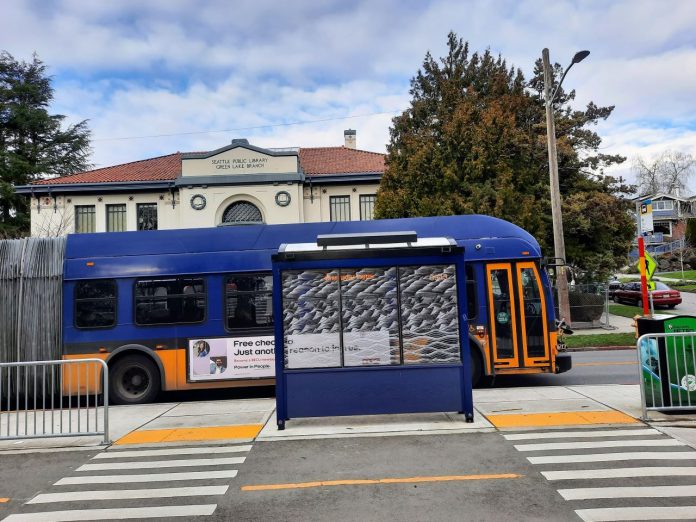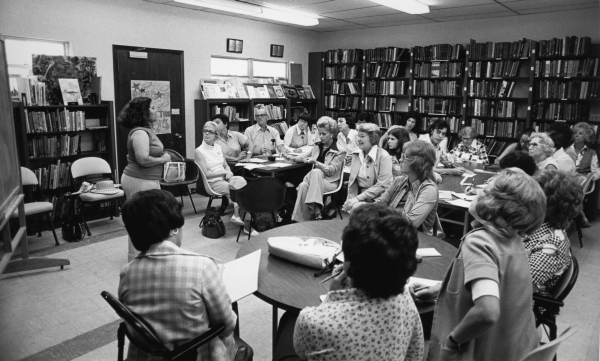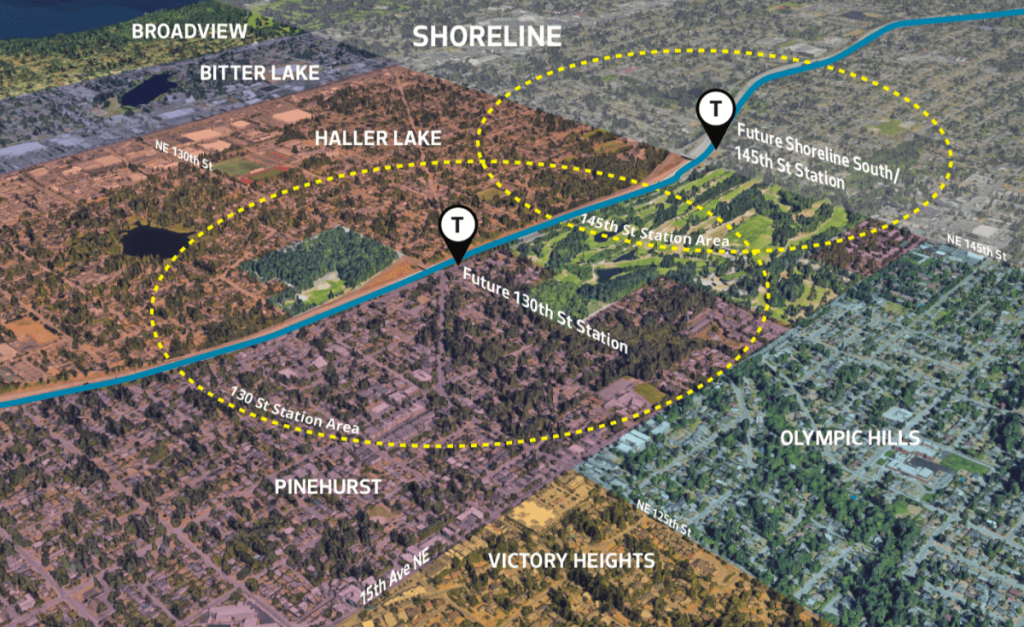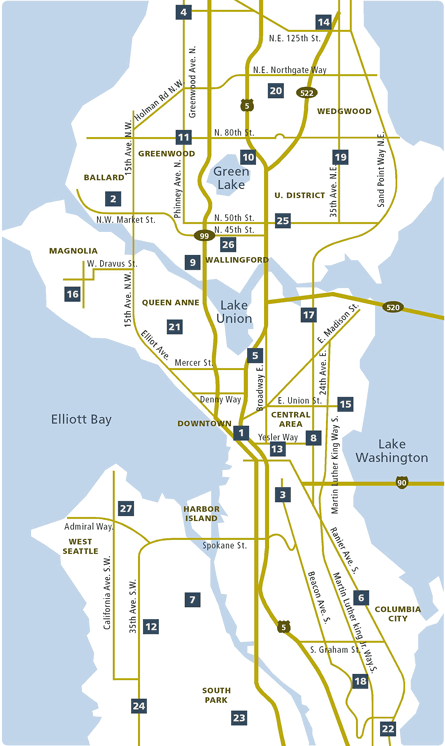
These six ideas would create a brighter future for local libraries by adapting to emerging needs.
Currently, both the Seattle Public Library (SPL) and the King County Library System (KCLS) are conducting surveys to inform future operations. The SPL survey is to inform SPL’s future strategic plan and the KCLS survey is more of a general patron satisfaction survey. Both surveys close soon, so now is the chance to make your voice heard.
- Fill out the Seattle Public Library survey by November 15th.
- Fill out the KCLS survey by November 17th.
Given that both library systems are in the midst of conducting surveys about their future direction, now is a good time to discuss the role libraries could play in the future of our region. Here are six ideas to make them more useful, ranging from climate change adaptation, to better multimodal access, to broader hours and use cases.
1) Strengthen library facilities for extreme weather events.
Build community resilience to extreme weather events by adding solar panels and battery storage to each library facility. To be clear, both SPL and KCLS are already weatherizing and making other physical improvements to their facilities, but adding solar panels and battery storage would provide some energy security, allowing facilities to continue to serve the public following an extreme weather event. Doing so could even pay for itself, thanks to possible energy tax credits available under the Inflation Reduction Act for local governments and nonprofits.

Urbanist contributor Clifford Heberden recently wrote about the city’s plans for resilience hubs. He mentioned the role libraries play in this. With the libraries carrying out community engagement now, followed by the city’s Office of Sustainability and the Environment in 2024, it will be important to be consistent and disciplined in asking for investments in infrastructure like this as part of supporting community resilience.
2) Double down on community activation

SPL and KCLS should reform the library’s community use policies and do everything possible to use the spaces as much as possible. This could involve targeted engagement with community organizations, schools, and nonprofits to encourage them to use library spaces. It would require an expansion of imagination in terms of what library spaces are and how they can be used. Some ideas:
- Use parking lots for community events;
- Trial weekly coffee and tea hours;
- Use meeting rooms for yoga classes;
- Trial food trucks at the most popular locations during busier hours;
- Trial flu shot drives;
- Add community gardens to libraries where there is space;
- Continue the trend of makerspaces;
- Consider recording studios;
- Add outdoor playgrounds at locations where the surrounding neighborhood lacks them;
- Add lending libraries for tools and niche household items (or provide awareness about existing similar programs at other area libraries).
- Lend board games;
- Add art classes;
- Replicate what the Oodi Library in Helsinki has done and add a small kitchen for cooking classes or to be used in conjunction with larger events;
- Add performance spaces for meetings, seminars, community theater groups, etc.;
- Add a small café in larger locations and structure the contracts so that small business owners are competitive in winning them.
3) Plan for future capital bonds
Start planning now for the next capital bond building program, focusing on how libraries will adapt to serve more dense communities. With more density, people will seek out more ‘third places’ like libraries, parks, and cafes. This is where the library can step in and really help to cement individuals’ sense of place and community. To do this though it will be necessary to plan for the physical improvements necessary for this to happen. The priority should be on expanding locations which experience consistently high usage (See #5 about library statistics), expanding in historically underserved areas, and adding new locations in areas which are zoned for high density and have large numbers of apartments planned or under construction.
This could take the form of adding by default a new library in conjunction with new light rail stations in areas where libraries are lacking or already experience high use. Junction and Judkins Park come to mind as places where this would make sense, as does the area surrounding the NE 130th Street Station in North Seattle if the area is to get a significant rezone though that is very much up in the air. Uptown and South Lake Union also lack a library branch, but will get light rail stations once Ballard Link is finally completed.

Regardless of the type of expansion, new ideas like off-site or basement book repositories, smaller libraries in ground floor commercial spaces, and building multi-story libraries should be considered (historically libraries in the Puget Sound Region have been largely single story). Each of these ideas has pros and cons but ultimately they all boil down to ways to expand service and improve the user experience by providing more space for studying, working, and reading in an efficient, user-friendly way.
4) Physically connect communities
Build safe walking, biking, and transit connections between library facilities and other major destinations. This will help make it easier and safer for community members to travel to and from the library and help to build out the region’s non-car transportation infrastructure. This does not necessarily have to cost the library systems money (municipal departments of transportation and state and federal grant funding could cover the costs), but it will require planning and staff resources to kickstart action, apply for grant funding, and do whatever it takes to get it over the finish line.
Libraries are key amenities to every neighborhood, and making sure it is safe and easy to walk, roll, bike, or take transit to the library will help to better connect the city not just physically but socially by improving library access for all.
5) Track library use
Both SPL and KCLS report annual usage statistics in the form of total numbers i.e., 140 nonprofit groups used free meeting room spaces, and 27,509 programs took place which served 620,509 attendees. Shifting these key performance indicators to figures which represent engagement per day and per location and per program would be more helpful in making programming decisions. In the same vein, KCLS currently breaks down circulation by region. The same should be done for programs, attendees, and program hours.
6) Stabilize funding streams
Finally, and perhaps most importantly, sort out and stabilize the funding structure and funding streams. The KCLS’s last lid lift levy expired in 2018 which, combined with inflation, has eroded the library’s ability to adequately fund operations and personnel which translates into a diminished user experience.
A lot of these ideas are reliant on adequate staff to plan, organize, execute and provide service, but even excluding this, the library needs to be able to fund its operations. It is understandable that KCLS chose not to try to pass a levy lid lift in 2020 due to the pandemic, but three years have gone by and inflation continues to eat away at the library’s budget.
While SPL’s budget is more diversified and has not fallen as significantly in recent years, both systems experience similar issues.
Before we can expand the library’s mission it is necessary to stop the bleeding that is currently occurring and ensure sufficient resources exist to maintain and normalize current services. This would include the normalization of library hours – ideally seven days a week and regular hours, i.e. 9am to 9pm – instead of the current shifting schedule which is confusing for patrons and makes it difficult to build the library into one’s daily schedule.
In 2019 there were 1,218 employees at KCLS, but by 2023 staff levels had fallen to just over 800. This clearly needs to be addressed because while some shrinkage might be justified, to lose 35% of your workforce should not be something that is done lightly and will undoubtedly affect morale and the library’s ability to serve the public.
Looking ahead
Purists will argue that the library should stick to its historical function of providing books and study spaces. Yes. But, the world has changed and libraries must adapt. The Puget Sound region has some of the most successful libraries in the country. Let’s keep moving forward, and make sure we are investing in and positioning our libraries to continue to serve the public well into the future.

Nathaniel Nichol (Guest Contributor)
Nathaniel Nichol recently moved back to the Seattle area after living in the Netherlands for several years. He cares deeply about high quality walking, biking, and transit infrastructure, high-density housing, and strong social anchor institutions like libraries and community centers.

